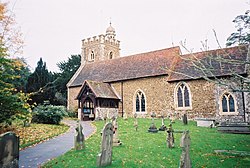Binfield
| Binfield | |
| Berkshire | |
|---|---|
 All Saints Church | |
| Location | |
| Grid reference: | SU8471 |
| Location: | 51°25’55"N, -0°47’31"W |
| Data | |
| Population: | 7,475 (2001) |
| Post town: | Bracknell |
| Postcode: | RG42 |
| Dialling code: | 01344 |
| Local Government | |
| Council: | Bracknell Forest |
| Parliamentary constituency: |
Windsor |
Binfield is a swollen village in the east of Berkshire. The village lies 2 miles northwest of Bracknell and 3 miles northeast of Wokingham, and is reckoned to sit uncomfortably on the westernmost extremity of the 'Greater London Urban Area'.
According to the 2001 census, Binfield has a population of 7,475.
Name
The name of the village appears to be the Old English beornet feld, meaning "bent-grass field".
Churches
All Saints
All Saints Church was built in the 17th century, though most of the structure today is of the mid-19th century. Of particular note is the 17th century hourglass and elaborate iron stand. It features the arms of the Farriers' Company of London. The poet Alexander Pope lived at Pope's Manor in Popeswood and sang in the church choir as a boy in the early 1700s.
Others
- Church of England:
- All Saints
- St Mark's
- Evangelical: Binfield Free Church
- Seventh-day Adventist: Newbold Church
History
This was once a forested landscape. The surrounding forest was cleared after the Enclosure Act of 1813, allowing Binfield to grow and drawing farm labourers for the new farmland.
The Stag and Hounds was reportedly used as a hunting lodge by Henry VIII and Elizabeth I and an elm tree outside it (the stump of which was finally removed in 2004 – it was ravaged by Dutch Elm Disease in the 1970s) was said to mark the centre of Windsor Forest.
The village is said to have been a refuge for a number of Parliamentary soldiers during the Civil War. The lodge became a coaching inn in 1727. The 18th-century travel writer, William Cobbett, once stayed there and wrote that it was "a very nice country inn". He called nearby Bracknell a "bleak and desolate" place.
John Constable spent his honeymoon at the Rectory in 1816 and sketched 'All Saints Church' twice.
From the late 19th century to the 1960s, brick-making was an important industry in the area, with the Binfield Brick and Tile works at Amen Corner being an important employer – this is now the site of the Coppid Beech Hotel and the John Nike Leisuresport Complex. The presence of large houses in the area, most of them without estates to support them, meant that many tradesmen could make a living in the village and Binfield continued to flourish until the development of Bracknell New Town. Binfield bricks were partly used to create the Royal Albert Hall in London.
Houses and manors
Binfield Manor was built in 1754 by Sir William Pitt (a distant cousin of Pitt the Elder, Earl of Chatham) at a cost of £36,000. It is currently owned by the Sultan of Brunei.
Binfield Place, a mostly Jacobean Manor (partly of Henry VII's reign) with a mysteriously missing wing. The 'Luck of Binfield' hung here: a 17th-century bas-relief of a lady's head, said to pour misfortune upon any owner who removes it. The grounds of the manor are used every summer for a large party for locals, called "Party at the Place".
Binfield House, similar in appearance to Horace Warpole's Strawberry Hill House near Twickenham (Grade II listed) was built in 1776 and for nearly 150 years was rented out to a number of wealthy tenants. In the mid-19th century the house was used for at least 35 years as a small school. In 1928 it was bought by Lady Knox who with her husband Major General Knox rebuilt and greatly extended the house under the guidance of the architect Nugent Cachemaille-Day. Binfield House was sold in 1974 to the then Bracknell District Council.
Allanbay Park stands two miles north of Binfield: a country house set in parkland.[1]
About the village
Binfield is home to Newbold College.
There are two primary schools: a Church of England school and a Seventh-day Adventist primary school.
Binfield has four public houses: The Roebuck, The Victoria Arms, the Jack O'Newbury and the Stag and Hounds. In addition to these there are a number of former public houses in the village, which include an ancient ale houses along Wicks Green (The Kicking Donkey) and a since demolished public house along Red Rose (The White Horse).
There is also a doctors' surgery, a dental surgery, a pharmacy, three hairdressing salons, an art shop, a supermarket, a coffee shop and two estate agents. There are a number of chip shops and take-aways.
Sport
- Archery: The Bowmen Of Warfield
- Cricket: Binfield CC founded in 1865
- Football: Binfield FC
Outside links
| ("Wikimedia Commons" has material about Binfield) |
References
- ↑ Allanbay Park - British Listed Buildings
